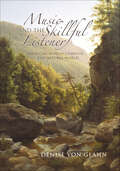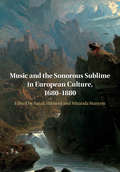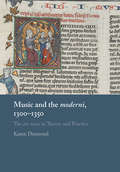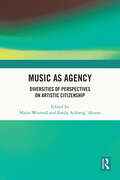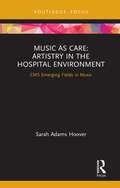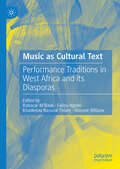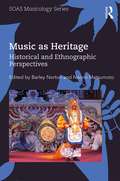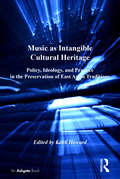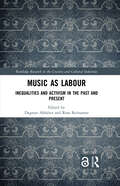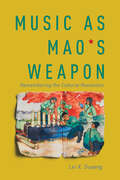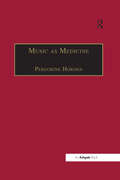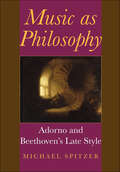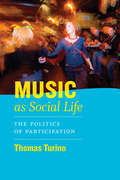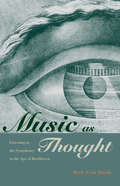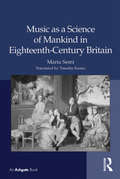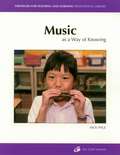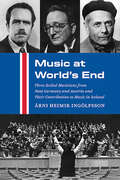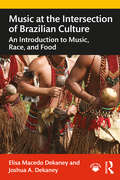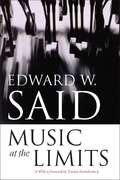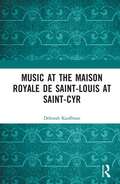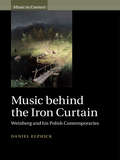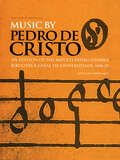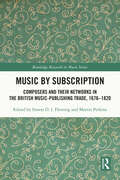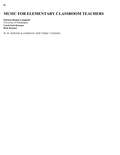- Table View
- List View
Music and the Skillful Listener: American Women Compose the Natural World (Music, Nature, Place)
by Denise Von GlahnFor Denise Von Glahn, listening is that special quality afforded women who have been fettered for generations by the maxim "be seen and not heard." In Music and the Skillful Listener, Von Glahn explores the relationship between listening and musical composition focusing on nine American women composers inspired by the sounds of the natural world: Amy Beach, Marion Bauer, Louise Talma, Pauline Oliveros, Joan Tower, Ellen Taaffe Zwilich, Victoria Bond, Libby Larsen, and Emily Doolittle. Von Glahn situates "nature composing" among the larger tradition of nature writing and argues that, like their literary sisters, works of these women express deeply held spiritual and aesthetic beliefs about nature. Drawing on a wealth of archival and original source material, Von Glahn skillfully employs literary and gender studies, ecocriticism and ecomusicology, and the larger world of contemporary musicological thought to tell the stories of nine women composers who seek to understand nature through music.
Music and the Sonorous Sublime in European Culture, 1680–1880
by Sarah Hibberd Miranda StanyonThe sublime - that elusive encounter with overwhelming height, power or limits - has been associated with music from the early-modern rise of interest in the Longinian sublime to its saturation of European culture in the later nineteenth century and beyond. This volume offers a historically situated study of the relationship between music, sound and the sublime. Together, the authors distinguish between the different aesthetics of production, representation and effect, while understanding these as often mutually reinforcing approaches. They demonstrate music's strength in playing out the sublime as transfer, transport and transmission of power, allied to the persistent theme of destruction, deaths and endings. The volume opens up two avenues for further research suggested by the adjective 'sonorous': a wider spectrum of sounds heard as sublime, and (especially for those outside musicology) a more multifaceted idea of music as a cultural practice that shares boundaries with other sounding phenomena.
Music and the moderni, 1300–1350: The ars nova in Theory and Practice
by Karen DesmondMusic theorists labelled the musical art of the 1330s and 1340s as 'new' and 'modern'. A close reading of writings on music theory and the polyphonic repertory from the first half of the fourteenth century reveals a modern musical art that arose due to specific innovations in music notation. The French ars nova employed as its theoretical fundament a new system for arranging musical time proposed by the astronomer and mathematician Jean des Murs. Challenging prevailing accounts of the ars nova, this book presents the 'new art' within the intellectual context of its time, revises the datings of Jean des Murs's writings on music theory, and presents the intersection of theory and practice for a crucial era in the history of music. Through contemporaneous accounts, Desmond explores how individuals were involved in 'changing' music in early fourteenth-century France, and the technical developments they pursued that precipitated this stylistic change.
Music as Agency: Diversities of Perspectives on Artistic Citizenship
by Emily Achieng’ Akuno Maria WestvallMusic as Agency: Diversities of Perspectives on Artistic Citizenship focuses on the concept, application, interpretation and manifestation of Artistic Citizenship in diverse contexts. The key concepts that the book tackles are: Cultural experience, artistic practice, musical identities, equity, democracy, community, activism, resistance and empathy.In giving an overview of aspects of the compound concept of artistic citizenship, Akuno and Westvall present the outcome of research and interrogation of practice by a global network of educator-researchers from Africa, the Americas, Asia and Europe. The book articulates notions of artistic citizenship, coming up with the term artizenship as a derivative of the composite term. It further explains and analyses practical ways of perceiving and relating to art spaces, art practices and arts objects towards belonging, being and becoming in a global space that is disparate, polarised and often alienating, and thus responding to issues such as social justice, identity, participation and inclusion. With a focus on music, the book targets musicians, scholars, educators and enthusiasts keen on gaining a deeper understanding of how music and musicking can influence human interactions towards social integration, trust, cultural awareness and intercultural understanding.
Music as Biology
by Dale PurvesWhy do human beings find some tone combinations consonant and others dissonant? Why do we make music using only a small number of scales out the billions that are possible? Dale Purves shows that rethinking music theory in biological terms offers a new approach to centuries-long debates about the organization and impact of music.
Music as Care: CMS Emerging Fields in Music (CMS Emerging Fields in Music)
by Sarah Adams HooverThis book provides an overview of professional musicians working within the healthcare system and explores programs that bring music into the environment of the hospital. Far from being onstage, musicians in the hospital provide musical engagement for patients and healthcare providers focused on life-and-death issues. Music in healthcare offers a new and growing area for musical careers, distinct from the field of music therapy in which music is engaged to advance defined clinical goals. Rather, this volume considers what happens when musicians interact with the clinical environment as artists, and how musical careers and artistic practices can develop through work in a hospital setting. It outlines the specialized skills and training required to navigate safely and effectively within the healthcare context. The contributors draw on their experiences with collaborations between the performing arts and medicine at Boston University/Boston Medical Center, University of Florida/UF Health Shands Hospital, and the Peabody Institute/Johns Hopkins Medicine. These experiences, as well as the experiences of artists spotlighted throughout the volume, offer stories of thriving artistic practices and collaborations that outline a new field for tomorrow's musical artists.
Music as Cultural Text: Performance Traditions in West Africa and its Diasporas
by Fallou Ngom Babacar M’Baye Khadimou Rassoul Thiam Alioune WillaneAfrican music&’s most distinctive feature is the urbatextuality that transpires through its diversity and plural functions and the specific geographical, cultural, religious, linguistic, political, economic, and social contexts from which it evolves. This music and its circum-Atlantic offspring are characterized by wisdom, subtlety, resilience, and creativity. They are cultural texts marked by an openness to other customs and societies since they maintain authenticity that does not foreclose hybridity, cosmopolitanism, and other global human sensibilities. These elements have made West African music a transnational commodity and a source of inspiration and survival both on the continent and in the black diaspora. Such patterns characterize Pan-African musical traditions that thrive in several spaces where both plurality and authenticity are welcome. These characteristics are apparent in rich, complex, and vibrant musical cultures such as rap in Senegal, France, and Burkina Faso, Malian traditional music in Canada and France, hip-life and hip-hop in Ghana, Christian songs in Ghana and Nigeria, and ngoyaan, Cape Verdean cabo, and zouk in Senegal. African music&’s distinctive features are also noticeable in Niger&’s guitar-playing traditions and Tuareg oral poetry as well as in Senegambian blues that influenced their African American offspring whose imprints they bear. By exploring all these elements, the chapters in this book pay homage to the heterogeneity, memories, hope, pain, and humanity in the music of Africa and the black diaspora.
Music as Heritage: Historical and Ethnographic Perspectives (SOAS Musicology Series)
by Barley Norton Naomi MatsumotoAs economic, technological and cultural change gathers pace across the world, issues of music heritage and sustainability have become ever more pressing. Discourse on intangible cultural heritage has developed in complex ways in recent years, and musical practices have been transformed by safeguarding agendas. Music as Heritage takes stock of these transformations, bringing new ethnographic and historical perspectives to bear on our encounters with music heritage. The volume evaluates the cultural politics, ethics and audiovisual representation of music heritage; the methods and consequences of music transmission across national borders; and the perennial issues of revival, change and innovation. UNESCO’s 2003 Convention for the Safeguarding of the Intangible Cultural Heritage provides an essential reference point for studies of music heritage. However, this volume also pays attention to important spheres of musical activity that lie outside of UNESCO’s reach and the reasons why some repertories of music are chosen for safeguarding while others are not. Some practices of art music in Europe explored in this book, for example, have received little attention despite being susceptible to endangerment. Developing a comparative framework that cuts across genre distinctions and disciplinary boundaries, Music as Heritage explores how music cultures are being affected by heritage discourse and the impact of international and national policies on grass-roots music practices.
Music as Intangible Cultural Heritage: Policy, Ideology, and Practice in the Preservation of East Asian Traditions (SOAS Studies in Music Series)
by Keith HowardFocussing on music traditions, these essays explore the policy, ideology and practice of preservation and promotion of East Asian intangible cultural heritage. For the first time, Japan, Korea, China and Taiwan - states that were amongst the first to establish legislation and systems for indigenous traditions - are considered together. Calls to preserve the intangible heritage have recently become louder, not least with increasing UNESCO attention. The imperative to preserve is, throughout the region, cast as a way to counter the perceived loss of cultural diversity caused by globalization, modernization, urbanization and the spread of the mass media. Four chapters - one each on China, Korea, Taiwan and Japan - incorporate a foundational overview of preservation policy and practice of musical intangible cultural heritage at the state level. These chapters are complemented by a set of chapters that explore how the practice of policy has impacted on specific musics, from Confucian ritual through Kam big song to the Okinawan sanshin. Each chapter is based on rich ethnographic data collected through extended fieldwork. The team of international contributors give both insider and outsider perspectives as they both account for, and critique, policy, ideology and practice in East Asian music as intangible cultural heritage.
Music as Labour: Inequalities and Activism in the Past and Present (Routledge Research in the Creative and Cultural Industries)
by Dagmar AbfalterThis book brings together research at the intersection of music, cultural industries, management, antiracist politics and gender studies to analyse music as labour, in particular highlighting social inequalities and activism. Providing insights into labour processes and practices, the authors investigate the changing role of manifold actors, institutions and technologies and the corresponding shifts in the valuation and evaluation of music achievements that have shaped the relationship between music, labour, the economy and politics. With research into a variety of geographic regions, chapters shed light on the various ways by which musicians’ work is performed, constructed and managed at different times and show that musicians’ working practices have been marked by precarity, insecurity and short-term contracts long before capitalism invited everybody to ‘be creative’. In doing so, they specifically examine the dynamics in music professions and educational institutions, as well as gatekeepers and mechanisms of inclusion and exclusion. With a specific emphasis on inequalities in the music industries, this book will be essential reading for scholars seeking to understand the collective actions and initiatives that foster participation, inclusion, diversity and fair pay amongst musicians and other workers.
Music as Mao's Weapon: Remembering the Cultural Revolution
by Lei X. OuyangChina's Cultural Revolution (1966-1976) produced propaganda music that still stirs unease and, at times, evokes nostalgia. Lei X. Ouyang uses selections from revolutionary songbooks to untangle the complex interactions between memory, trauma, and generational imprinting among those who survived the period of extremes. Interviews combine with ethnographic fieldwork and surveys to explore both the Cultural Revolution's effect on those who lived through it as children and contemporary remembrance of the music created to serve the Maoist regime. As Ouyang shows, the weaponization of music served an ideological revolution but also revolutionized the senses. She examines essential questions raised by this phenomenon, including: What did the revolutionization look, sound, and feel like? What does it take for individuals and groups to engage with such music? And what is the impact of such an experience over time? Perceptive and provocative, Music as Mao's Weapon is an insightful look at the exploitation and manipulation of the arts under authoritarianism.
Music as Medicine: The History of Music Therapy Since Antiquity
by Peregrine HordenMusic, whether performed or heard, has been seen as therapeutic in the history of many cultures. How have its therapeutic properties been conceptualized and explained? Which cultures have used music therapy? What were their aims and techniques, and how much continuity is there between ancient, medieval and modern practice? These are the questions addressed by the essays in this volume. They focus on the place of music therapy in European intellectual, medical and musical traditions, from their classical roots to the development of the music therapy profession since the Second World War. Chapters covering the Judaic, Islamic, Indian and South-East Asian traditions add global, comparative perspectives. Music as Medicine is the first book to establish the whole shape of the history of music therapy in a systematic and scholarly way. It addresses the problem of defining what music therapy has meant in different cultures and periods, and sets the agenda for future research in the subject. It will appeal to a diverse readership of historians, musicologists, anthropologists, and practitioners.
Music as Philosophy: Adorno and Beethoven's Late Style (Musical Meaning and Interpretation)
by Michael SpitzerBeethoven's late style is the language of his ninth symphony, the Missa Solemnis, the last piano sonatas and string quartets, the Diabelli Variations, the Bagatelles, as well as five piano sonatas, five string quartets, and several smaller piano works. Historically, these works are seen as forging a bridge between the Classical and Romantic traditions: in terms of their musical structure, they continue to be regarded as revolutionary.Spitzer's book examines these late works in light of the musical and philosophical writings of the German intellectual Theodor Adorno, and in so doing, attempts to reconcile the conflicting approaches of musical semiotics and critical theory. He draws from various approaches to musical, linguistic, and aesthetic meaning, relating Adorno to such writers as Derrida, Benjamin, and Habermas, as well as contemporary music theorists. Through analyses of Beethoven's use of specific musical techniques (including neo-Baroque fugues and counterpoint), Spitzer suggests that the composer's last works offer a philosophical and musical critique of the Enlightenment, and in doing so created the musical language of premodernism.
Music as Social Life: The Politics of Participation
by Thomas TurinoThomas Turino explores why music and dance are so often at the center of our most profound personal and social experiences and how the special properties of music and dance that make them fundamental resources for connecting with our own lives, our communities, and the environment.
Music as Thought: Listening to the Symphony in the Age of Beethoven
by Mark Evan BondsBefore the nineteenth century, instrumental music was considered inferior to vocal music. Kant described wordless music as "more pleasure than culture," and Rousseau dismissed it for its inability to convey concepts. But by the early 1800s, a dramatic shift was under way. Purely instrumental music was now being hailed as a means to knowledge and embraced precisely because of its independence from the limits of language. What had once been perceived as entertainment was heard increasingly as a vehicle of thought. Listening had become a way of knowing. Music as Thought traces the roots of this fundamental shift in attitudes toward listening in the late eighteenth and early nineteenth centuries. Focusing on responses to the symphony in the age of Beethoven, Mark Evan Bonds draws on contemporary accounts and a range of sources--philosophical, literary, political, and musical--to reveal how this music was experienced by those who heard it first. Music as Thought is a fascinating reinterpretation of the causes and effects of a revolution in listening.
Music as a Science of Mankind in Eighteenth-Century Britain
by Maria Semi translated by KeatesMusic as a Science of Mankind offers a philosophical and historical perspective on the intellectual representation of music in British eighteenth-century culture. From the field of natural philosophy, involving the science of sounds and acoustics, to the realm of imagination, involving resounding music and art, the branches of modern culture that were involved in the intellectual tradition of the science of music proved to be variously appealing to men of letters. Among these, a particularly rich field of investigation was the British philosophy of the mind and of human understanding, developed between the seventeenth and eighteenth centuries, which looked at music and found in its realm a way of understanding human experience. Focussing on the world of sensation - trying to describe how the human mind could develop ideas and emotions by its means - philosophers and physicians often took their cases from art's products, be it music (sounds), painting (colours) or poetry (words as signs of sound conveying a meaning), thus looking at art from a particular point of view: that of the perceiving mind. The relationship between music and the philosophies of mind is presented here as a significant part of the construction of a Science of Man: a huge and impressive 'project' involving both the study of man's nature, to which - in David Hume's words - 'all sciences have a relation', and the creation of an ideal of what Man should be. Maria Semi sheds light on how these reflections moved towards a Science of Music: a complex and articulated vision of the discipline that was later to be known as 'musicology'; or Musikwissenschaft.
Music as a Way of Knowing
by Nick PageNick Page loves to make and share music with his students, and it's likely that you will too by the time you've finished his passionate, thought-provoking book. You will also have developed a new understanding of and appreciation for the role music can play in supporting learners. A music educator and song leader who has devoted his professional life to helping people of all ages realize that they are "capable of great miracles through the simple, yet powerful, act of singing," Nick is particularly devoted to multicultural music and works diligently to promote music of diverse cultures. Rich with ideas on how to use music in the classroom, Music as a Way of Knowing will appeal especially to classroom teachers who are not musicians, but who enjoy and learn from music and want to use it with their students. Indeed, Nick reveals the truth of the Zimbabwean adage: "If you can talk, you can sing. If you can walk, you can dance. " Nick provides simple instructions for writing songs, using music to support learning across the curriculum, teaching singing effectively, and finding good songs. He assures you that with time, all students can sing well. The good news is that once you've read this book, you'll have the confidence to trust yourself-and your students-to sing and learn well through the joy and power of music.
Music at World's End: Three Exiled Musicians from Nazi Germany and Austria and Their Contribution to Music in Iceland
by Árni Heimir IngólfssonIn Iceland in the 1930s, classical music was only beginning to be seriously practiced, at the same time when musicians of Jewish heritage were fleeing Nazi Germany and Austria. Despite the country’s strict immigration policy, three outstanding young musicians were allowed to settle there: Robert Abraham, Heinz Edelstein, and Victor Urbancic. Their influence on Iceland’s music scene as conductors, instrumentalists, teachers, and scholars proved invaluable. In Music at World's End, the first in-depth study of the lives and careers of these three musicians, musicologist Árni Ingólfsson examines their formative years in Germany and Austria, their dramatic escapes from the Nazi regime, and their triumphs and frustrating setbacks in their new homeland, a country in which Jews were virtually unknown. This fascinating case study is a valuable addition to studies of musical exile during World War II and beyond.
Music at the Intersection of Brazilian Culture: An Introduction to Music, Race, and Food
by Elisa Macedo Dekaney Joshua A. DekaneyMusic at the Intersection of Brazilian Culture takes an interdisciplinary approach by utilizing several aspects of Brazilian music, race, and food as a window to understanding Brazilian culture, with music at the core. Through a holistic understanding of the Brazilian experience – exploring issues of race, colonization, sustainable development, and the contributions of the three distinct ethnic groups in the making of Brazil – the authors create a narrative based on their own recollection of memories, traditions, customs, sounds, and landscapes that they experienced in Brazil. Each engaging section begins with an overview of the topic that places it in historical context, and then focuses on each subtopic with a thorough presentation of the content as well as suggested activities that can be implemented in the classroom. The chapters conclude with a list of useful references, resources, and audio recording examples, which are available on Spotify, to present readers with a musical landscape of the folktales. These can be found online via the Routledge catalogue page for this book. This book is an essential resource for students and teachers of music and cultural studies, as it unpicks complex issues to help readers better understand and appreciate Brazilian culture.
Music at the Limits: Three Decades Of Essays And Articles On Music
by Edward SaidMusic at the Limits is the first book to bring together three decades of Edward W. Said's essays and articles on music. Addressing the work of a variety of composers, musicians, and performers, Said carefully draws out music's social, political, and cultural contexts and, as a classically trained pianist, provides rich and often surprising assessments of classical music and opera.Music at the Limits offers both a fresh perspective on canonical pieces and a celebration of neglected works by contemporary composers. Said faults the Metropolitan Opera in New York for being too conservative and laments the way in which opera superstars like Pavarotti have "reduced opera performance to a minimum of intelligence and a maximum of overproduced noise." He also reflects on the censorship of Wagner in Israel; the worrisome trend of proliferating music festivals; an opera based on the life of Malcolm X; the relationship between music and feminism; the pianist Glenn Gould; and the works of Mozart, Bach, Richard Strauss, and others. Said wrote his incisive critiques as both an insider and an authority. He saw music as a reflection of his ideas on literature and history and paid close attention to its composition and creative possibilities. Eloquent and surprising, Music at the Limits preserves an important dimension of Said's brilliant intellectual work and cements his reputation as one of the most influential and groundbreaking scholars of the twentieth century.
Music at the Maison royale de Saint-Louis at Saint-Cyr
by Deborah KauffmanThe history of music at the Maison royale de Saint-Louis at Saint-Cyr — the famous convent school founded by Madame de Maintenon and established by Louis XIV in 1686 as a royal foundation — is both rich and intriguing; its large repertory of music was composed expressly for young female voices by important composers working within significant contemporary musical genres: liturgical chant, sacred motets, theatrical music, and cantiques spirituels. While these genres reflect contemporary styles and trends, at the same time the works themselves were made to conform to the sensibilities and abilities of their intended performers. Even as Jean-Baptiste Moreau's music for Jean Racine’s biblical tragedies Esther and Athalie shows a number of similarities to contemporary tragédies lyriques, it departs from that more public genre in its brevity, generally simpler solo writing, and the integral use of the chorus. The musical style of the choral numbers closely parallels that of other choral music in the repertory at Saint-Cyr. The liturgical chant sung in the church was composed by Guillaume-Gabriel Nivers, and is an example of plain-chant musical, a type of new ecclesiastical composition written during the seventeenth and eighteenth centuries, primarily for female religious communities in France. The large repertory of petits motets (short sacred Latin pieces for solo voice), mostly composed by Nivers and Louis-Nicolas Clérambault, are simpler and more restrained than works by their contemporaries. A close study of the motets reveals much about changes to musical style and performance practices at Saint-Cyr during the eighteenth century. The cantique spirituel, a song with a spiritual text in the vernacular French language, played a significant role in both the education and recreation of the girls at Saint-Cyr. Cantiques composed for the girls vary widely in terms of their style and difficulty, ranging from simple strophic melodies to more sophisticated works in the style of contemporary airs. In all cases, the stylistic features of the music for Saint-Cyr reflect a careful consideration of the needs and capabilities of the young singers of the school, as well as an awareness of the rigorous requirements of Madame de Maintenon, who kept a close watch over the propriety of all things relating to the piety, behavior, and image of her charges.
Music behind the Iron Curtain: Weinberg and his Polish Contemporaries (Music in Context)
by Daniel ElphickMieczysław Weinberg left his family behind and fled his native Poland in September 1939. He reached the Soviet Union, where he become one of the most celebrated composers. He counted Shostakovich among his close friends and produced a prolific output of works. Yet he remained mindful of the nation that he had left. This book examines how Weinberg's works written in Soviet Russia compare with those of his Polish contemporaries; how one composer split from his national tradition and how he created a style that embraced the music of a new homeland, while those composers in his native land surged ahead in a more experimental vein. The points of contact between them are enlightening for both sides. This study provides an overview of Weinberg's music through his string quartets, analysing them alongside Polish composers. Composers featured include Bacewicz, Meyer, Lutosławski, Panufnik, Penderecki, Górecki, and a younger generation, including Szymański and Knapik.
Music by Pedro de Cristo (Music Archive Publications #Vol. 1)
by Owen ReesFirst Published in 1999. Routledge is an imprint of Taylor & Francis, an informa company.
Music by Subscription: Composers and their Networks in the British Music-Publishing Trade, 1676–1820 (Routledge Research in Music)
by Simon D. I. Fleming Martin PerkinsThis book breaks new ground in the social and cultural history of eighteenth-century music in Britain through the study of a hitherto neglected resource, the lists of subscribers that were attached to a wide variety of publications, including musical works. These lists shed considerable light on the nature of those who subscribed to music, including their social status, place of employment, residence, and musical interests. Through broad analysis of subscription data, the contributors reveal insights into social and economic changes during the period, and the types of music favoured by groups like music clubs, the aristocracy, the clergy, and by men and women. With chapters on female composers and listeners, music and the slave economy, musical patronage, the print trade, and nationality, this book provides innovative perspectives that enhance our understanding of music’s social spheres, the emergence of music publishing, and the potential of digital musicology research.
Music for Elementary Classroom Teachers
by Patricia Shehan Campbell Carol Scott-Kassner Kirk KassnerLearn how to use the power of music to enhance other subjects. Written for both elementary education majors and K-6 classroom teachers, the text is rooted in cognitive research on children’s development. <p><p>The book offers myriad instructional plans that weave songs, dances, and carefully constructed listening experiences into subjects ranging from language arts and social studies to mathematics, science, and the arts. It also provides opportunities for engaging children in expressive-creative practices.
